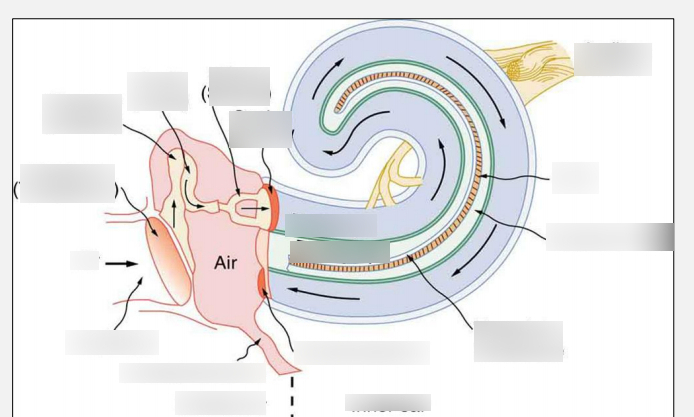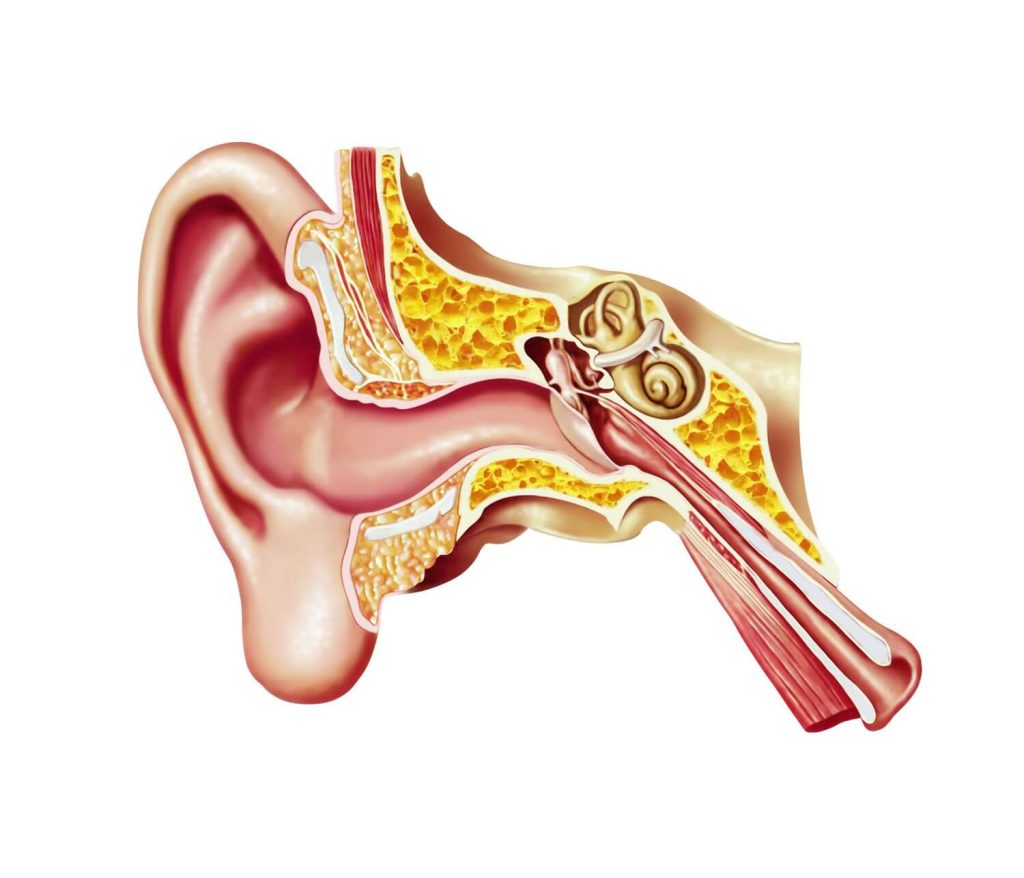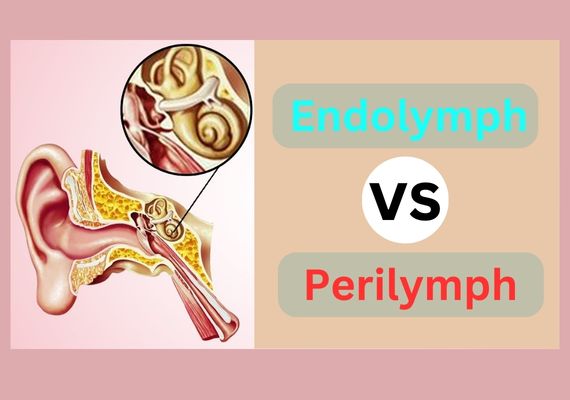Introduction to Endolymph and Perilymph
Perilymph and Endolymph are vital fluids that support the inner ear’s functionality, especially Endolymph found in the cochlear duct and vestibular system. Which contains high potassium concentrations but low levels of sodium concentration. Perilymph in the cochlea’s vestibule scala and Tympani contains large quantities of sodium while having lower potassium concentrations this provides important balance and hearing assistance.
Sound waves travel through these fluids, protecting inner ear structures from injury while helping maintain spatial alignment and equilibrium. Their different compositions and functions support vestibular and auditory perception, but issues like Meniere’s disease or perilymphatic fistulas may create balance and hearing problems that need attention.
What is Endolymph?
Endolymph is an inner ear fluid that serves to facilitate both hearing and balance functions, located within its membranous labyrinth structure. This fluid can be found within both the cochlear duct and vestibular compartments of the vestibular system. One notable characteristic of endolymph is its unique ionic composition containing high concentrations of potassium ions (K+) while an unusually low level of sodium ions (Na+).
This unique electrolyte combination plays a critical role in transducing vibrations into electrical signals that can then be understood by your brain as auditory sensations. Endolymph is an integral component of the cochlea, bathing its hair cells that line the cochlear duct with fluid that supports its sensory receptor function and responds to mechanical vibrations produced by sound waves.

When sound travels along a fluid-filled cochlear duct, vibrations cause stereocilia deflections that trigger electrochemical responses in auditory nerve fibers associated with these hair cells that eventually reach brain receptors and result in the perception of sound.
Endolymph is also essential to the vestibular system, aiding with head movement detection, acceleration detection, and maintaining balance. Composition and flow regulation is regulated by special cells known as the stria vascularis for optimal inner ear sensory mechanism function.
Any disruptions in endolymph’s composition or regulation could lead to Meniere’s disease characterized by episodes of vertigo hearing loss and tinnitus that shows its significance as part of protecting auditory and vestibular health.
What is Perilymph?
Perilymph is an essential inner ear fluid located inside the bony labyrinth and membranous labyrinth, along with several chambers comprising the vestibular system. Perilymph plays an essential role in transmitting sound while aiding balance and spatial orientation.
Perilymph exhibits an unusual ionic structure. This layer is distinguished by a higher level of sodium ions (Na+) but decreased potassium Ions (K+). This electrolyte mixture plays a pivotal role in transmitting sound while maintaining electrochemical gradients necessary to sustain proper sensory system functionality.

Perilymph plays an integral part in the auditory system Perilymph acts to transfer sound energy through the middle ear to the inner ear, by means of vibration. Soundwaves hitting the cochlea cause resonances within fluid surrounding vestibule scala vibrations to travel down the cochlear duct, moving hair cells within the cochlear tube. These neuronal signals arrive at the brain for processing into hearing information.
Perilymph plays an essential part in the vestibular system by sensing head movement, acceleration, and equilibrium. When moving the head causes perilymph to release inertia through semicircular canals that stimulate hair cells – giving crucial data regarding one’s position in space.
Perilymph can play an essential role in keeping balance and hearing functioning normally; understanding its function is integral for comprehending how our vestibular and auditory senses function together.
What is the importance of Endolymph and Perilymph in the Mammalian Ear
Endolymph and perilymph are critical elements of mammalian inner ears, playing key roles in hearing and balance processes. Their special fluids facilitate transducing sensory stimuli to neural signals which the brain interprets.
Endolymph, with its characteristic high potassium and low sodium concentration levels, plays an integral role in translating sound vibrations to electrical impulses and then into auditory signals for brain perception. Within the cochlea, sensory hair cells convert mechanical vibrations to auditory signals by being bathed by Endolymph.
Endolymph provides electrochemical gradients necessary for stimulating hair cell stimulation thereby accurately depicting sound perception by brain cells. Endolymph plays an essential part in vestibular systems used for tracking head movement detection as well as maintaining balance. It plays its role here too enabling accurate perception by maintaining balance throughout.
Perilymph with its unique sodium-potassium balance serves as the medium for sound transmission from the middle ear to the cochlea. Not only does it carry vibrations but it also cushions them to protect delicate structures of the inner ear from excessive motion and shocks. Perilymph also plays a significant role in vestibular system operations by sensing head movements and providing information regarding spatial orientation and equilibrium.
Endolymph and perilymph play more than simply fluid roles: they form the backbone for complex processes involved with hearing and balance in mammals, such as hearing aids. Their unique compositions and functions enable accurate sensory perception and spatial awareness further underscoring their essential role within auditory and vestibular systems.
Structure of Endolymph and Perilymph
Endolymph and perilymph are two distinct fluids found within the inner ear that play important roles in auditory and vestibular processes, respectively. Endolymph is located within the membranous labyrinth encompassing the cochlear duct and several segments of the vestibular system.
Its high potassium concentration in comparison with low sodium content plays an essential part in turning sound vibrations into electrical signals through stimulating hair cells within the cochlea, leading to auditory perception; while also helping detect head movement accelerations and spatial orientation within vestibular systems.
Perilymph fills the spaces surrounding a membranous labyrinth, filling spaces such as cochlea scala vestibule and cochlea tympani as well as semicircular canals and vestibule of vestibular apparatus. Perilymph contains higher sodium concentration and relatively reduced potassium concentration compared to endolymph, acting as a conduit to transmit sound vibrations between the middle ears to the inner ear.
Protecting delicate cochlear structures from sound vibrations transmitted between the middle ears to the inner ear while stimulating hair cells within the vestibular system for the sensation of balance sensation through stimulation of hair cells within the vestibular system these differing compositions and distribution are key in order to maintaining auditory and vestibular functions simultaneously.
Composition and Functions of Endolymph
Endolymph is a unique fluid found within the inner ear’s membranous labyrinth that plays an integral part in both hearing and balance. With its distinctive composition and functions, endolymph plays an integral part in hearing and balance functions for human ears.
Endolymph stands out as having its own distinctive ionic composition compared to other bodily fluids, and can be identified by:
High Potassium Ion Concentrations:
- Endolymph contains high concentrations of potassium ions (K+), creating a positive endolymphatic potential.
- Conversely, endolymph has significantly lower concentrations of sodium ions (Na+).
Functions:
Auditory Function
Endolymph is vitally important to the functioning of our auditory systems:
- Hair Cell Stimulation: In the cochlea, sound vibrations cause deflections in stereocilia located within the endolymph. Due to high potassium concentration levels within endolymph, an electrochemical signal initiates which results in auditory nerve stimulation.
- Signal Transmission: These electrical impulses travel along auditory nerve fibers into the brain where they are processed as sound by interpreting what is called auditory cortex neural nets (also called auditory nerve).
Vestibular Functions:
Endolymph helps contribute to maintaining balance and spatial orientation functions provided by vestibular systems:
- Head Movement Detection: Hair cells stimulated by movement of endolymph due to head rotation are detected within the semicircular canals of the vestibular system and send signals about head movement back to the brain, informing about it as soon as they detect movement of endolymph due to head rotations.
- Acceleration and Balance: Changes in endolymph flow within the vestibule provide information about acceleration while helping maintain balance.
Ionic Homeostasis:
- Endolymphic concentrations are kept balanced through active transport of ions by special cells of the inner ear known as the stria vascularis; this cell actively transports these essential minerals.
Electrochemical Gradients:
- Endolymph concentrations that differ dramatically between potassium- and sodium-rich regions create electrochemical gradients across cell membranes that play an essential role in activating sensory cells to generate electrical impulses that generate electrical signals for sensory neurons to interpret as electrical pulses.
Composition and Functions of Perilymph
Perilymph is an intricate body fluid found inside of the inner ear that plays an essential role in both auditory and vestibular systems, such as hearing.
Composition:
Perilymph has its own distinct ionic composition that sets it apart from endolymph and other body fluids:
- High Sodium (Na+) Concentration: Perilymph contains high concentrations of sodium ions (Na+), contributing to its positive perilymphatic potential.
- Lower Potassium Ions Concentrations: When compared with endolymph, perilymph has relatively lower potassium ion (K+) concentration.
Functions of Perilymph:
Auditory Transmission:
Perilymph plays an essential role in transmitting sound vibrations from the middle ear to the inner ear:
- Sound Amplification: Incoming soundwaves that reach the middle ear cause vibrations within ossicles that travel up into oval window of cochlea, where perilymph moves within its scala vestibuli of cochlea causing movement within it.
- Mechanical Transmission: Fluid movement disrupts cochlear partition, stimulating hair cells that convert mechanical vibrations into auditory signals for perception.
Protection of Cochlear Structures:
- Perilymph can play an essential role in safeguarding delicate cochlear structures like hair cells and basilar membrane by cushioning against vibrations and movements that might lead to damage or discomfort in these delicate organs.
Vestibular Function:
- Perilymph plays an essential part in helping maintain balance and spatial orientation by contributing fluid from its vessels into the vestibular system, helping it play its part for balance and orientation purposes.
Semicircular Canal Function:
- When head rotation generates fluid movement within semicircular canals, fluid-generated signals give us valuable information regarding both direction and speed of head movement.
Acceleration and Equilibrium:
- Alterations in perilymph flow within the vestibule help detect acceleration while also maintaining equilibrium.
Ionic Homeostasis:
- Perilymph’s ionic composition is actively managed by cells dedicated to maintaining it; this helps ensure its distinct character and proper functionality.
Electrochemical Gradients:
- Differences in ion concentration between perilymph and the fluid surrounding cells generate electrochemical gradients, enabling sensory cells to generate electrical signals via electrical currents flowing between perilymph and cell fluids.
Clinical significance of Endolymph and Perilymph
Endolymph and perilymph have immense clinical importance as components that play vital roles in various inner ear disorders that impact hearing and balance, including hearing loss and balance impairments.
Endolymph-Related Clinical Significance:
- Meniere’s Disease: Meniere’s is an abnormal build-up of endolymph within the cochlea and vestibular system that results in vertigo attacks, hearing loss, tinnitus and sensation of fullness in one ear. Any fluctuation of endolymph volume has the ability to upset this delicate equilibrium causing significant disturbances both auditory and vestibular functions.
- Endolymphatic Hydrops: Similar to Meniere’s disease, Endolymphatic Hydrops is characterized by excessive endolymph buildup. It may result from head trauma or infection and cause symptoms including vertigo and hearing loss.
Perilymph-Related Clinical Significance:
- Perilymphatic Fistula: This condition occurs when there is a tear or hole in the membrane between the middle ear and inner ear that separates perilymph from entering the middle ear, allowing perilymph to leak into it and create dizziness, hearing loss, and sensations of pressure or fullness within the middle ear. Symptoms may include dizziness and hearing loss as well as dizziness with sensation of pressure or fullness within the middle ear.
- Perilymphatic Gusher: This condition occurs rarely and typically during surgical ear procedures when excessive perilymph leakage takes place, leading to hearing loss or balance disturbances and potentially even complete hearing impairment.
- Cochlear Implants: Understanding the composition and behavior of perilymph is integral for successful cochlear implant surgery, where the electrode array must be placed as close as possible to structures bathed with perilymph for effective sound transmission.
Balance issues in endolymph and perilymph composition, circulation or containment can result in inner ear disorders affecting hearing and balance, so understanding their clinical importance is imperative for diagnosing and managing conditions that impact these systems.
How Endolymph and Perilymph Imbalances Can Affect Your Health
Imbalances between endolymph and perilymph can have detrimental repercussions for health, particularly with regard to hearing and balance.
Such imbalances could arise as the result of various causes and lead to various disorders or symptoms:
Endolymph Imbalances:
- Meniere’s Disease: An excessive build-up of endolymph in the cochlea and vestibular system is at the root cause of Meniere’s disease, marked by episodes of severe vertigo, fluctuating hearing loss, tinnitus (ringing in the ears) and fullness in one ear. This disorder must be managed carefully as symptoms often worsen over time unless treatment begins immediately.
- Endolymphatic Hydrops: Similar to Meniere’s disease, Endolymphatic Hydrops involves abnormal accumulation of endolymph, leading to symptoms including vertigo and hearing loss as well as other issues concerning your ears.
Perilymph Imbalances:
- Perilymphatic Fistula: An opening between the middle and inner ears may allow perilymph to leak into the middle ear due to trauma, loud noises or pressure fluctuations (such as while diving scuba). Symptoms may include dizziness, hearing loss, and pressure in your ear canal.
- Cochlear Implant Surgery: Improper implant placement or inadequate perilymph sealing can result in leaks, negatively impacting its success and hearing outcomes.
- Perilymphatic Gusher: When performing certain surgical procedures to treat inner ear malformations, excessive perilymph leakage may occur and result in hearing loss and balance disturbances.
- Congenital Malformations: Certain congenital inner ear malformations may lead to abnormal perilymph circulation and cause hearing and balance problems for newborn babies.
Key Difference Between Endolymph and Perilymph
Here’s a comparison chart highlighting the key differences between endolymph and perilymph:
| Aspect | Endolymph | Perilymph |
|---|---|---|
| Location | Within the cochlear duct and vestibular system | Surrounding the membranous labyrinth |
| Ionic Composition | High potassium (K+), low sodium (Na+) | High sodium (Na+), low potassium (K+) |
| Role in Hearing | Converts sound vibrations into electrical signals | Transmits sound vibrations to the cochlea |
| Role in Balance | Helps detect head movement and maintain balance | Contributes to spatial orientation and equilibrium |
| Cochlear Function | Stimulates hair cells for auditory perception | Transmits sound vibrations to cochlear structures |
| Vestibular Function | Participates in detecting head movements | Aids in detecting head movements and acceleration |
| Electrochemical Gradients | Generates electrical potentials | Creates electrochemical differences for sensory cell activity |
| Clinical Significance | Imbalances lead to Meniere’s disease | Perilymphatic fistulas and cochlear implant success |
| Barrier Protection | Separated from surrounding tissues by barriers | Helps protect inner ear structures |
Conclusion
Imbalances between endolymph and perilymph fluids found within the inner ear can result in various health concerns. Endolymph imbalances have been linked to conditions like Meniere’s disease, leading to vertigo and hearing problems; leakage from injuries or surgeries, leakages can result in dizziness, hearing loss, and balance disturbance.
Such imbalances disrupt delicate functions within your inner ear that allow hearing as well as maintaining equilibrium seeing medical attention should symptoms such as vertigo arise or balance issues persist for proper diagnosis and management of treatment options.

